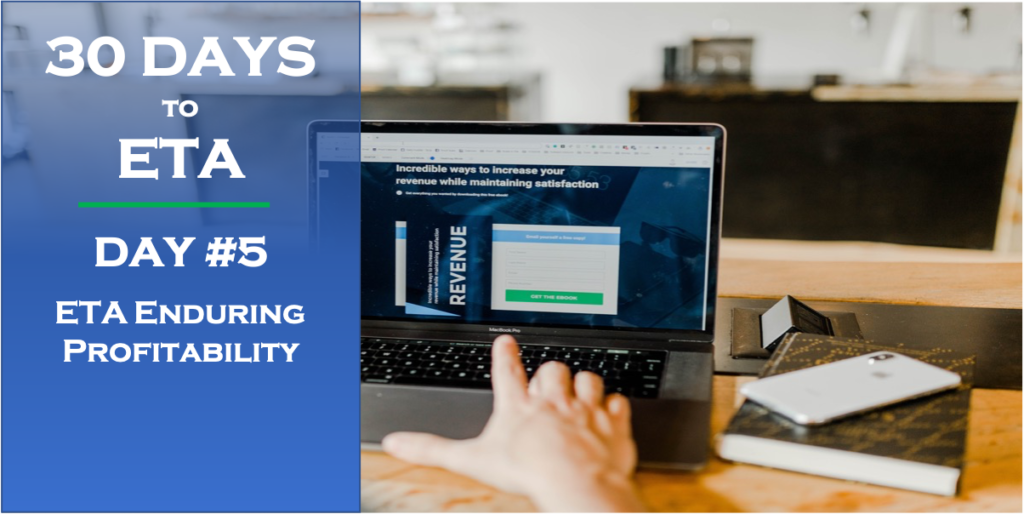Most recently in our 30 Days to ETA series, I’ve been dissecting the business characteristics that maximize or multiply your future company’s resale value. I’ve shared how to master competitive advantage, make your business scalable, hire a great staff, and build a cash reserve to weather the business storms (You can read the previous post by CLICKING HERE). Before leaping from our business’s acquisition to its growth phase further, I want to talk to you about leading yourself — the personal side of your business’s sustainability — Your personal sustainability: your physical well-being and how it affects your business’s value. Why? A strong mind requires a strong body to achieve the final destination of success… Enjoy!

Attend Webinar Workshop: 30 Days to ETA
Strong Body | Strong Mind (You Need Both)
I work with a lot of entrepreneurs/leaders. They tend to fall into a couple of different camps. Camp #1 is the strong mind one. Here, the leaders believe that they are playing chess, while everyone else is playing checkers. In other words, they’re the smartest people in the room (every room!) The other camp is the one with strong bodies. These are the leaders who believe that if they simply wake up at 5:00am and workout like a Navy SEAL that they will get wherever they need to be in business/life. They are in great physical shape, and I am typically envious, but they fall short. In order to be a leader of a small business on this Entrepreneurship Through Acquisition journey you’ll need to have both strong mind and strong body.
You will have to anticipate the effects the long trip an Acquisition Entrepreneur makes when it comes to leading yourself. You have to prepare your mind and body to withstand the monotonous sitting and seemingly endless journey. Maybe you plan to entrepreneur trip with others who can take turns driving with you. Or maybe you plan stops along the way to walk around to stretch your legs and get your circulation flowing. Whatever you do, you have to take care of yourself in order to reach the destination you’ve already mapped out.
You only have one body and mind.. You’d better take care of them accordingly!
Sam Palazzolo, Managing Director @ Tip of the Spear Ventures
Reaching a Business Acquisition State
Buying a business is hard. Making a business sellable in the end, or attractive to the market will seem harder. It takes a lot of time and energy. Strength and resolve become more important than speed. These are the keys to getting yourself into a Business Acquisition State for Mergers & Acquisitions.
If you as a small business owner haven’t adequately prepared yourself for the grueling business journey, your physical body or mental stability could give out before your company does. If you want your business to survive trials and tribulations, don’t you want to make it to the finish line with your business?
Your business’s survival, its sustainability, is one thing. Your personal sustainability is another.
Personal Versus Business Well-Being
We entrepreneurs think we can accomplish anything and everything. Business owners are notorious for burning the candle at both ends. Typically, we spend 60, 70, and 80 hours a week working on our business. Since eating, sleeping, resting, and exercising don’t appear to contribute to our business’s immediate profitability or sustainability, we don’t make them priorities in our lives. Our personal welfare becomes the sacrifice on the altar of our business.I heard a statistic that in the recent COVID-19 pandemic the average person gained 20 pounds (Scary!)
However, ignoring your needs will eventually lead to a crash within your business. Your physical body cannot sustain lack of sleep, poor diet, and constant energy consumption. When your physical body starts to break down, your mind will begin to lose its clarity and sustainability as well. With both physical and mental fatigue affecting your abilities, your business’s capability will struggle as well. How can you make logical decisions with no sleep or direct your team from a hospital bed?
Personal Sustainability Ideas for the Entrepreneur Through Acquisition
pending time taking care of your physical health and mental well-being is important. As you make business plans, gather team members, and implement systems, you also need to plan time for yourself. Don’t just make a business plan; make a personal sustainability plan. Include time to:
- Sleep – If you have to, write down the actual time you should be in bed at night to get the recommended eight hours of sleep your body needs. More than that, don’t bring work to bed. Leave it. Turn your phone on vibrate. You’ll accomplish more tomorrow after a good night’s sleep than you will tonight with no sleep.
- Eat – Plan client meetings at restaurants during lunch. Or, have a team member bring in food at a certain time each day. Let sales’ representatives provide team lunches while they teach continuing education courses or do product presentations. Don’t leave meals to chance. Know what you’ll eat and where you’ll eat each day so that you don’t forget to eat or forget to eat well.
- Exercise – Even if a typical gym membership is not feasible for you, movement can be. You don’t have to lift weights or run five miles a day. You just have to move. Run up and down the stairs in your building once or twice every hour. Get your blood flowing by doing some jumping jacks at your desk. Walk to the mailbox. Find times and places in your normal day to add in movement. Don’t forget that exercise has the benefit of helping you sleep better, too.
- Meditate – Practice yoga, pray, have quiet time, read, spend an hour with a therapist or do whatever else you can to give your mind a break from the stress of daily business. Your mind can’t refocus without rest.
- Relax – This isn’t the same as sleeping or meditating. To me, relaxation is time spent doing something you love to do, something that makes you happy. Whether it’s spending time on a hobby, spending a day on the lake, or going to a movie, do it. Schedule a back massage or a lunch with friends. Your happiness should contribute to your business’s success, not be a victim of it.
SUMMARY
Leading yourself seems so simple. After all, who will listen to you 100% of the time and follow your direction? The answer should be you! You may think it’s a bit ridiculous, but take it from someone who’s been in business for 25 years. You’ll take time for yourself one way or another. Either you’ll make a plan for self-care, or your body will demand care. Whether your body shuts down, the good Lord stops you, or your family demands time of you, something is going to happen. You’ll make time one way or another. Why not do it on your own accord?
Why not take a little bit of time over the next few months or year and invest in yourself, starting right now before you own your business? It really is that simple. If you are not sustainable personally, your business will never be sustainable. Your team will fall apart. Even your family could fall apart. I’ve seen it all throughout my years working with clients. I’ve seen business owners file for bankruptcy and divorce. They’ve been hospitalized or stricken with preventable diseases.
This is just a gentle reminder to take care of yourself. Be prepared for whatever comes your way. Life has a way of balancing things out, whether you plan for it or not!
Sam Palazzolo



